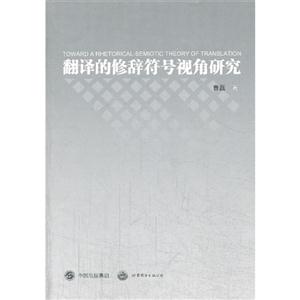-
>
心理学经典文丛:女性心理学
-
>
贫困一代:被社会囚禁的年轻人
-
>
乌合之众:大众心理研究(英汉双语修订版)(套装共2册)
-
>
始于极限:女性主义往复书简
-
>
融合文化(新媒体和旧媒体的冲突地带)/文化和传播译丛
-
>
看不见的女性
-
>
县乡中国:县域治理现代化
翻译的修辞符号视角研究 版权信息
- ISBN:9787510053610
- 条形码:9787510053610 ; 978-7-5100-5361-0
- 装帧:一般胶版纸
- 册数:暂无
- 重量:暂无
- 所属分类:>
翻译的修辞符号视角研究 本书特色
《翻译的修辞符号视角研究》在构建修辞符号学理论的基础上,在现有的翻译理论框架下探讨修辞符号学视角的翻译研究,《翻译的修辞符号视角研究》旨在解决翻译的符号意义问题,演示修辞符号学如何为符合的翻译建立逻辑范式,由此阐释两种语言系统和文化之间符号翻译中的意义缺失。
翻译的修辞符号视角研究 内容简介
《翻译的修辞符号视角研究》在构建修辞符号学理论的基础上,在现有的翻译理论框架下探讨修辞符号学视角的翻译研究,《翻译的修辞符号视角研究》旨在解决翻译的符号意义问题,演示修辞符号学如何为符合的翻译建立逻辑范式,由此阐释两种语言系统和文化之间符号翻译中的意义缺失。
翻译的修辞符号视角研究 目录
chapter 1 introduction
1.1 origin and rationale for the present study
1.2 definitions of key terms
1.3 objectives of the research
1.4 methodology
1.5 organization of the dissertation
chapter 2 literature review
2.1 about translation studies
2.1.1 definition and development of translation studies
2.1.2 integrated and interdisciplinary approaches to translation studies
2.1.2.1 integrated approaches to translation studies
2.1.2.2 interdisciplinary approaches to translation studies
2.1.3 non-western traditions in translation studies
2.1.4 new trends
2.2 issues and debates in translation studies
2.2.1 equivalence
2.2.1.i nida's concept of formal equivalence
2.2.1.2 nida's concept of dynamic equivalence
2.2.1.3 other concepts of equivalence
2.2.1.4 summary
2.2.2 context in translating
2.2.2.1 register analysis
2.2.2.2 context and translation
2.2.2.3 summary
2.2.3 the translator's role
2.2.3.1 the translating process
2.2.3.2 translatability and untranslatability
2.2.3.3 foreignization and domestication
2.2.3.4 summary
chapter 3 toward a rhetorical-semiotic approach in translation studies
3.1 key concepts in semiotics
3.1.1 the meaning of signs
3.1.2 semiotics
3.1.2.1 de saussure's sign systern
3.1.2.2 peircean signification system
3.1.2.3 roland barthes' notion
3.1.3 semiotic science
3.1.3.1 logical semiotics
3.1.3.2 linguistics as a branch of semiotics
3.1.3.3 syntax, semantics and pragmatics
3.1.3.4 semiotics of texts
3.2 semiotic approach toward rhetoric
3.2.1 the revival and development of western rhetoric
3.2.2 peirce's rhetorical turn
3.2.3 semiotic approach toward rhetoric
3.3 toward a rhetorical-semiotic approach in translation studies
3.3.1 translation and semiotics
3.3.2 rhetorical translation studies
3.3.3 the translating of meaning
3.3.4 message decoding and encoding —— the process of translation
3.3.4.1 context
3.3.4.2 code
3.3.4.3 decoding and encoding
3.4 summary
chapter 4 rhetorical encoding of linguistic signs
4.1 communication, linguistic expressions and rhetorical encoding of linguistic signs
4.1.1 characteristics o{ communicative activities
4.1.2 definition of rhetorical encoding
4.1.3 guidelines of rhetorical encoding
4.1.3.1 conventions
4.1.3.2 logic
4.1.3.3 appropriateness
4.1.3.4 pragmatic purposes
4.2 classification of rhetorical encoding
4.2.1 logic rhetorical encoding of linguistic signs
4.2.1.1 the category of logic signs
4.2.1.2 basic function of logic rhetoric
4.2.1.3 meticulous, compact and intact quality
4.2.1.4 denotative and monosemantic referential meaning
4.2.1.5 objective, reasoning and "hot" messages
4.2.2 aesthetic rhetorical encoding of linguistic signs
4.2.2.1 expressive aesthetic signs
4.2.2.2 aesthetic and emotional functions
4.2.2.3 flexible and open quality
4.2.2.4 connotative semantic reference
4.2.2.5 subjective, emotional and "cold" messages
4.2.3 semantic rhetorical encoding and rhetorical encoding of linguistic forms
4.2.3.1 thoughts and emotions
4.2.3.2 linguistic images
4.3 summary
chapter 5 rhetorical decoding of linguistic signs
5.1 definition of rhetorical decoding
5.2 the capabilities required by rhetorical decoding of
linguistic signs
5.2.1 a thorough knowledge of the linguistic sign system
5.2.2 strong capability of logic thinking and reasoning
5.2.3 strong image thinking ability
5.2.4 being rhetorically and artistically accomplished
5.2.5 correspondent cognitive abilities, intellectual level and emotional experience
5.3 classification of rhetorical decoding
5.3.1 logic rhetorical decoding of linguistic signs
5.3.1.1 literal logic decoding of linguistic signs
5.3.1.2 free logic decoding of linguistic signs
5.3.2 aesthetic decoding of linguistic signs
5.3.2.1 semantic interpretation
5.3.2.2 image aesthetic appreciation
5.4 summary
chapter 6 the retaining of meaning in translation from rhetorical semiotic perspective
6.1 the integration of rhetorical semiotics and translation studies
6.1.1 the feasibility of applying rhetorical theory to translation studies
6.1.2 the construction of a dynamic meaning theory of translation
6.1.3 the retaining of meaning in translation from rhetorical-semiotic perspective
6.1.4 summary
6.2 the transfer of meaning
6.2.1 the transfer of linguistic meaning
6.2.1.1 orthographic and phonological barriers ..
6.2.1.2 grammatical barriers
6.2.1.3 barriers of figures of speech
6.2.2 the transfer of referential meaning
6.2.3 the transfer of pragmatic meaning
6.2.3.1 cultural words and expressions
6.2.3.2 idioms
6.2.3.3 figures of speech
6.2.3.4 the reproduction of register and other codes in translation
chapter 7 conclusions and implications
7.1 major findings and contributions of the study
7.2 limitations of the study
7.3 areas for further research
bibliography
acknowledgements
翻译的修辞符号视角研究 作者简介
作者曹磊,博士,上海外国语大学讲师,担任过多门课程授课老师,包括高级综合英语、听力与口译、语言学、视听等课程。发表的论文有《从符号学角度谈翻译》、《语篇修辞性与翻译》、《论口译和笔译的关系》、《语篇意识观照下的翻译》等。参与编写过多本专业英语教材,有自考本科教材《听力与口译》、《中级口译教程》、《基础口译教程》、《商务英语口语》等。
- >
我与地坛
我与地坛
¥16.8¥28.0 - >
苦雨斋序跋文-周作人自编集
苦雨斋序跋文-周作人自编集
¥6.9¥16.0 - >
上帝之肋:男人的真实旅程
上帝之肋:男人的真实旅程
¥19.3¥35.0 - >
中国人在乌苏里边疆区:历史与人类学概述
中国人在乌苏里边疆区:历史与人类学概述
¥24.0¥48.0 - >
莉莉和章鱼
莉莉和章鱼
¥18.1¥42.0 - >
随园食单
随园食单
¥20.6¥48.0 - >
名家带你读鲁迅:朝花夕拾
名家带你读鲁迅:朝花夕拾
¥10.5¥21.0 - >
巴金-再思录
巴金-再思录
¥33.1¥46.0
-
汉字有话说-说出中华文化原初样式
¥24.4¥58 -
中华经典指掌文库王昌龄诗集/中华经典指掌文库
¥15¥16 -
汉字王国
¥23.5¥46 -
真的不用读完一本书
¥11.2¥35 -
小书馆:古汉语入门
¥26.9¥39 -
语病百讲
¥9.9¥29
















